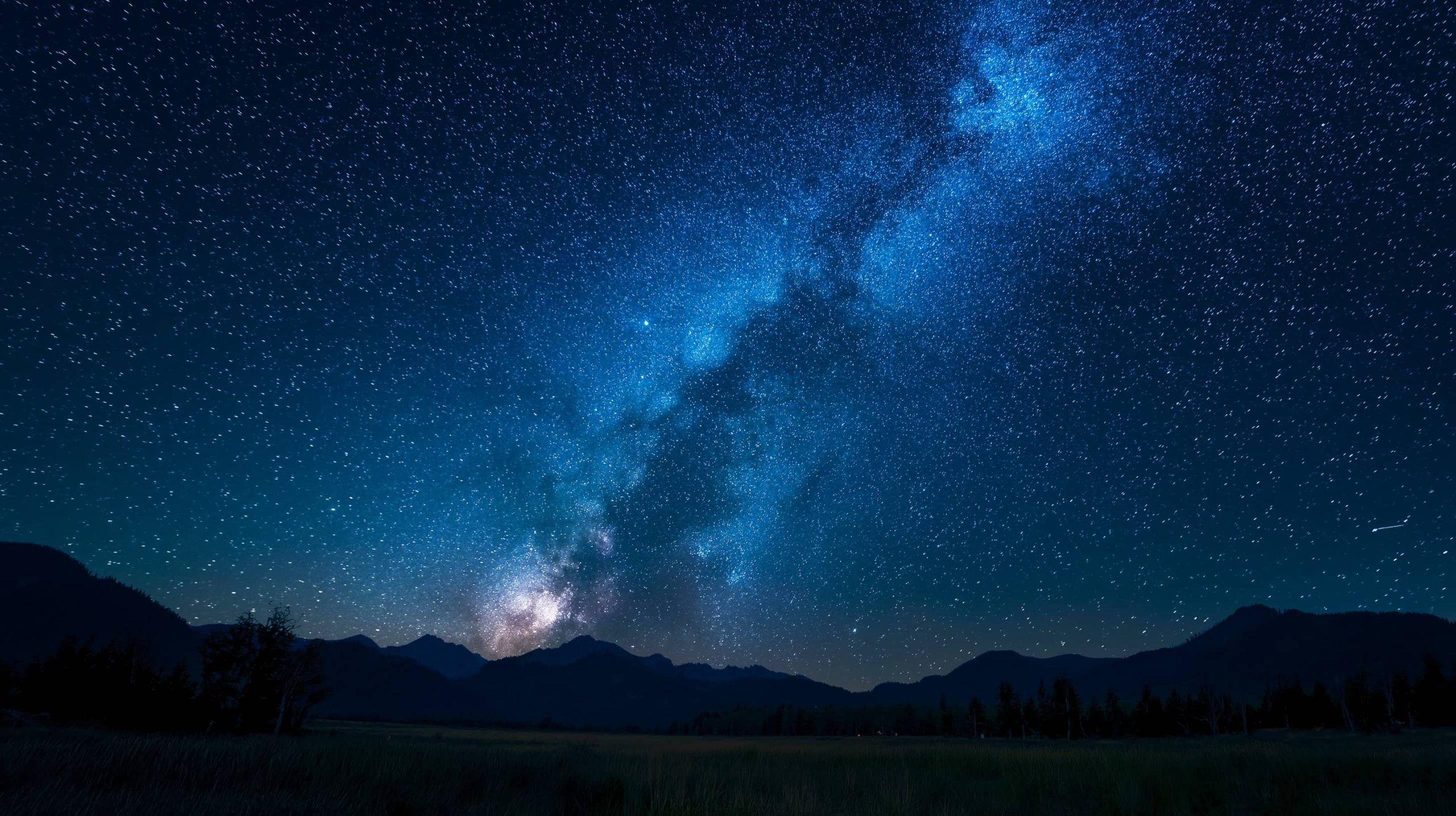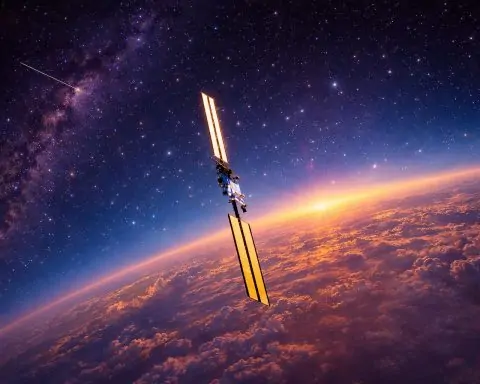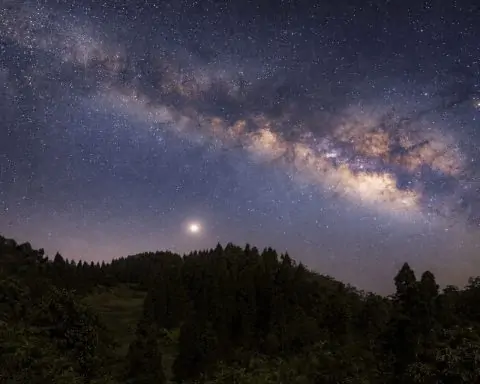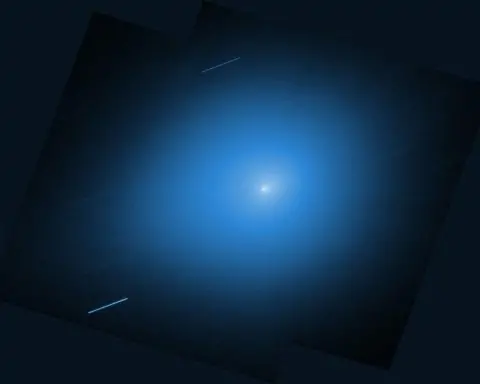- The New Moon on Aug 23, 2025 at 06:06 UTC creates a rare Black Moon, and Summer 2025 features four new moons (Jun 25, Jul 23, Aug 23, Sep 21), making Aug 24–25 moonless.
- Perseids are active until about Aug 24 and peaked on Aug 12–13, and with the Moon gone, observers could see roughly 5 meteors per hour late at night to dawn, while peak rates with Moon interference could reach around 15 per hour.
- Kappa Cygnids (Aug 3–28, peak Aug 16–18) may deliver slow, bright fireballs, typically at about 3 meteors per hour at best.
- Northern Hemisphere observers have the best Perseid and Cygnid views, with southern observers seeing mainly Perseid earthgrazers.
- Venus and Jupiter form a bright pre-dawn pair about 20–30 degrees above the eastern horizon before sunrise on Aug 24–25, with Venus around magnitude -4 and Jupiter around -2.
- Mercury reaches greatest western elongation on Aug 19 and remains visible very low in the east about 30–45 minutes before sunrise during Aug 24–25.
- Saturn rises in the east around 9–10 pm and stays visible all night at magnitude about +0.6, heading toward its 2025 opposition in late September.
- Mars is faint and fading, appearing low in the western sky after sunset and setting in twilight on Aug 24–25.
- Predawn ISS passes around Aug 23–25 can reach magnitudes of -1 or brighter, and Tiangong offers a separate satellite sighting in the same window.
- Starlink trains launched on Aug 17 and Aug 22 may appear after sunset or before sunrise, but by Aug 23–25 the trains have spread out and are less likely to form a prominent line.
The nights of August 24–25, 2025 are primed for an epic skywatching extravaganza. A “Black Moon” (new moon) guarantees dark, star-studded skies, setting the stage for meteor shower finales, a multi-planet “parade” at dawn, potential Northern Lights at high latitudes, and bright satellite flybys like the ISS. Space agencies and astronomers are buzzing – from NASA touting a stunning Venus-Jupiter meetup to NOAA monitoring solar activity. Below we break down each celestial highlight and how to catch it, with expert tips and sources. Mark your calendars, set those alarms, and look up – the universe is putting on a show!
Meteor Showers: Perseids’ Final Flickers and Surprise Fireballs
Perseid Meteors – Last Gasp: The famous Perseid meteor shower, which peaked in mid-August, is now winding down, but it’s not completely over [1]. The Perseids remain active until about August 23–24 [2], meaning a patient observer could still catch a few stray “shooting stars” these nights. Don’t expect the torrent of the peak (which can reach ~100 meteors/hour under ideal conditions) – especially since the peak on Aug 12–13 was spoiled by an 84%-full Moon this year, hiding many of the dimmer meteors [3] [4]. Now, with the Moon gone, any remaining Perseid streaks will stand out nicely against dark skies [5]. In fact, even a week after the peak, occasional bright Perseid fireballs are still possible, as this shower is known for spectacular long-lasting streaks [6]. Realistically, you might see on the order of a few meteors per hour (perhaps ~5 under good conditions) in the late night and pre-dawn hours [7] [8] – but any one of them could be a showstopper. Meteor expert Robert Lunsford of the AMS noted that under the Moon’s interference, peak Perseid rates were only ~15/hour at best [9]. Now, with New Moon darkness, even the few stragglers left should be easier to spot [10].
Viewing tips: To maximize your chances, find a dark location away from city lights and give your eyes time to adapt (20+ minutes) [11]. Plan to watch after local midnight until dawn, when Earth is facing into the meteor stream for a higher rate [12]. Lie back, scan the sky broadly (no telescope needed), and be patient [13]. The meteors can appear anywhere, though Perseid trails all point back to the northeast sky (Perseus) if traced backward [14]. Remember, meteor activity tends to come in spurts with lulls in between, so a solid hour or more of watching is recommended [15]. And even if Perseid counts are low, you’ll likely catch a few random “sporadic” meteors unrelated to any shower on any clear night [16].
Bonus Fireballs – Kappa Cygnids: August isn’t only about the Perseids. A minor shower called the kappa Cygnids has been active as well (roughly Aug 3–28, peaking around Aug 16–18) [17]. The κ-Cygnids are much weaker (only ~3 meteors/hour at best even at peak) [18], but they have a special reputation: they often produce slow, bright fireballs. In fact, NASA notes the kappa Cygnids have “delivered memorable fireballs in past years” despite their low numbers [19]. By late August the shower is fizzling, but if you see an especially long-lasting, slow meteor that doesn’t trace back to Perseus, you might have caught a Cygnid [20]. These fireballs emanate from the northern sky (near the constellation Cygnus, high overhead in the evening) [21]. Consider it an encore performance – a single brilliant meteor from a minor shower can still steal the show. As one astronomy publication quipped, with minor showers “most of the time you won’t see many, but there’s a chance of an eye-popping meteor” [22]. In short, keep your eyes peeled for any surprise fireballs lighting up the late-summer night.
Global note: The Perseids strongly favor the Northern Hemisphere – their radiant climbs high in northern skies, but stays low for those south of the equator [23]. Northern skywatchers in dark rural areas have the advantage this weekend for both Perseids and the odd Cygnid. Southern Hemisphere observers might only catch the rare Perseid “earthgrazer” skimming along the horizon [24], but can still enjoy the splendid Milky Way core overhead (more on that later). Either way, the moonless darkness will make any meteor you do see more vivid. Bundle up, get comfy, and keep looking up!
Black Moon = Ultra-Dark Skies (No Moonlight!)
While meteors provide the fireworks, the Moon (or lack thereof) is the unsung hero of this weekend. On August 23, the Moon reached its New Moon phase (exact at 06:06 UTC Aug 23) [25], marking an especially rare “Black Moon.” In astronomical terms, a “Black Moon” refers to an extra new moon in a season that usually has only three [26]. Summer 2025 has four new moons (June 25, July 23, Aug 23, Sept 21), making the Aug 23 new moon the third of those four – hence a Black Moon [27]. These seasonal Black Moons only happen about once every 33 months [28]. (The other definition of Black Moon – a second new moon in one calendar month – doesn’t apply this time [29].) What does this mean for skywatchers? In practical terms, it means no moonlight all night long, and exceptionally dark skies [30].
During a new moon, the Moon is positioned between Earth and Sun with its lit side facing away from us [31]. It rises and sets with the Sun and is essentially invisible against the daytime sky [32] (unless it happens to cause a solar eclipse, which this one does not). As a result, the nights of Aug 24–25 will be completely moonless, offering a rare treat: deep darkness ideal for stargazing [33]. Faint stars, the Milky Way’s dense star clouds, and meteor streaks that would normally be washed out by moonlight will pop into view with greater clarity [34]. If you can escape city lights, take advantage! The summer Milky Way (arching across Sagittarius, Scorpius, Cygnus overhead) is at its brightest this time of year, and without lunar glare you can see countless stars, star clusters, and nebulae on a clear night [35].
Although the Black Moon itself is invisible, keep an eye on the western sky after sunset for its return. By Sunday Aug 24 evening, a breathtakingly thin 1-day-old crescent Moon may be glimpsed. About 30–40 minutes after sunset on Aug 24, look low near the western horizon for a fragile silver sliver – that’s the young Moon, only ~1–2% illuminated [36]. It will be a delicate arc in the twilight (binoculars help if you have trouble spotting it) [37]. If you miss it Sunday, try Monday Aug 25 when the crescent will be a bit higher and ~5% sunlit – still a slender crescent, but a touch easier to see [38]. You might also notice “earthshine” on the dark side of the Moon – the ghostly glow of sunlight reflected off Earth faintly illuminating the lunar night. Catching an ultra-young Moon is a fun challenge even for seasoned observers. These first few evenings of the waxing crescent also let us watch the Moon’s journey – by Tuesday Aug 26 the crescent will slide near Mars in the dusk sky, and each night it climbs higher and thickens on its way to first quarter by Aug 31 [39].
No eclipse this time: This New Moon isn’t causing any eclipses on these dates (the Moon’s alignment isn’t precise enough with the Sun). The next significant lunar event will be a big one – a total lunar eclipse on Sept 7–8, 2025 [40] [41]. That “Blood Moon” will be visible across much of the world (Asia, Australia, Europe, Africa) and last over an hour [42]. So enjoy the clear dark nights now, and get excited for a dramatic red eclipse in two weeks. We’ll have more on that as it approaches!
Bottom line: The Black Moon means ideal viewing conditions this weekend. With the sky at its darkest, faint celestial sights emerge: for example, the Andromeda Galaxy is high in the east by late night, and the Summer Triangle overhead frames numerous star clusters and nebulas. If you have access to a telescope or binoculars, now’s a great time to sweep around Sagittarius and Cygnus – you’ll be amazed what a moonless sky reveals [43]. And for the naked eye observer, simply soaking in the Milky Way stretching overhead is a breathtaking experience.
Planets on Parade: Dawn Alignments and All-Night Saturn
Several planets are putting on their own show across the nights of Aug 24–25 – from dusk until dawn. All five naked-eye planets can be observed with some planning, and three of them form a beautiful grouping in the pre-dawn sky. Here’s where to find the planets:
- Venus & Jupiter – Brilliant Dawn Duo: If you’re up before sunrise, you can’t miss the two brightest planets shining low in the east. Venus has recently returned as the “Morning Star” and is blazing at magnitude –4 in the pre-dawn sky [44]. Look about 20–30° above the eastern horizon in the hour before sunrise – that dazzling beacon is Venus [45]. Not far from it is Jupiter, also in the eastern morning sky [46]. Jupiter is much less bright than Venus (about magnitude –2) but still outshines any true star at that hour [47]. Earlier this month, Venus and Jupiter had an extremely close conjunction (just ~1° apart on Aug 11–12) – one of the flashiest sky events of the year [48]. By Aug 24 they have separated a bit, but they’re still only a few degrees apart, making for an eye-catching pair of “stars” at dawn [49]. Venus will be the lower, more brilliant one; Jupiter will appear slightly higher (and for many observers, a bit to Venus’s north/right) but still very bright [50]. They shine with a steady light – unlike twinkling stars – and as dawn grows, Venus will be the last object visible before sunrise. NASA calls their August meetup “the real highlight of August” for skywatchers [51]. So if you haven’t already, try to catch this planetary pairing in the eastern twilight. (Extra treat: Through a telescope, you might see Jupiter’s moons or Venus’s crescent phase!)
- Mercury’s Trickier Appearance:Mercury – the innermost planet – is also visible at dawn, but it’s a challenge. It reached greatest western elongation (furthest from the Sun in the morning sky) on Aug 19 [52]. Around Aug 24–25, Mercury is still hanging very low in the east about 30–45 minutes before sunrise [53]. If you have a flat, unobstructed horizon (and perhaps binoculars), look for a modest star-like point just above the east-northeast horizon below Venus and Jupiter. It will only be visible in the very early twilight – by 20–30 minutes before sunrise it vanishes in the glare [54]. Many people have never seen Mercury with the naked eye (it’s often lost in sunlight), so this week is a good opportunity. Tip: Start scanning about 45 minutes before local sunrise, and stop once the sky becomes too bright (never look near the Sun as it’s rising!) [55]. Mercury will appear far below the Venus/Jupiter duo – a line drawn through Jupiter and Venus downward toward the horizon points to where Mercury emerges. Catching Mercury might be easiest around Aug 24–26 before it sinks back toward the Sun. Good luck – seeing the elusive Mercury is a special skywatcher merit badge!
- Saturn – Ringed Jewel All Night: Over in the opposite side of the sky, Saturn is the star of the late-night hours. The Ringed Planet is nearing its 2025 opposition (coming up in late September), which means it’s already biggest and brightest for the year [56]. Right now Saturn is shining around magnitude +0.6 [57] – as bright as a prominent star – in the constellation Aquarius. It rises in the east by mid-evening (~9–10 pm local time in late August) and stays visible all night [58], moving high across the southern sky and then into the west by dawn [59]. In other words, Saturn “comes up at sunset and sets at sunrise” when at opposition; we’re almost at that point now, so it’s effectively an all-night object. Look for a steady, pale yellowish point in the southeast after dark – that’s Saturn [60]. Unlike twinkling stars, planets shine steadily, and Saturn will be one of the brighter points in that area of sky. If you have a telescope, now is prime time to view Saturn’s stunning rings and moons. Even a decent pair of binoculars might show a tiny oval disk or hint of Titan (Saturn’s largest moon) nearby [61]. Fun fact: Around opposition, Saturn’s rings brighten a bit due to an effect called the Seeliger effect – you might notice Saturn appearing just a touch extra-brilliant [62]. Also, earlier this week (Aug 18) observers with telescopes caught Titan’s shadow transiting Saturn – a rare event [63], underscoring that Saturn is indeed well-placed for observation now. Don’t miss Saturn ruling the late summer nights – it’s a beautiful sight even to the naked eye, and through a scope it’s unforgettable.
- Mars – Fading at Dusk:Mars is the one major planet that’s a bit out of the spotlight this month. It has been lingering low in the western sky at sunset, but it’s now very faint and disappearing into twilight. Mars is currently much farther from Earth than earlier this year, so it’s only about as bright as a Big Dipper star and sets shortly after the Sun [64]. If you want to try spotting it, look just after sunset low in the west, near where the sun went down. By Aug 24–25, a slim crescent Moon will join Mars on the 26th, but on the 24th and 25th the Moon is essentially absent or a thin sliver very low. Realistically, Mars will be tough to see for most casual observers due to the glow of dusk. Don’t worry – later this year and especially in 2027 Mars will return to brilliance during a closer opposition. For now, consider Mars a bonus target: if you have binoculars and a clear view, you might glimpse a ruddy point of light very close to the horizon in evening twilight.
All told, if you plan well you can see all five classical naked-eye planets in one night this weekend. In the evening, try for Mars briefly after sunset (west), then enjoy Saturn rising and soaring through the night, and by early morning look east to catch Mercury, Venus, and Jupiter together before sunrise [65] [66]. In fact, during the pre-dawn hours of Aug 25, you could momentarily see four planets at once: Saturn setting in the west while Venus, Jupiter, Mercury align in the east [67]. That’s a true planet parade across the sky! (And for the record, Uranus and Neptune are up there too – Neptune not far from Saturn in Aquarius, and Uranus in Aries before dawn – but you’d need a telescope or good binoculars to spot those ice giants [68].) This kind of multi-planet display is relatively rare, so take a moment to enjoy the solar system spread out before your eyes. As NASA’s skywatching team might say, it’s one of those times where “the planets align” for a fantastic viewing opportunity.
Expert tip: Planets don’t twinkle like stars do. If you see a bright point of light that’s shining steadily, there’s a good chance it’s a planet [69]. Enjoy identifying these distant worlds with just your eyes, and consider pointing a telescope at Jupiter or Saturn for extra wow factor (Jupiter’s cloud bands and moons, and Saturn’s rings, are visible even in small telescopes) [70].
Auroras & Space Weather: Quiet After the Geomagnetic Storm
After the planets and meteors, one question remains: Will the Northern (or Southern) Lights come out to play? The answer is: probably not much this weekend, barring an unexpected solar outburst. But it’s worth understanding why, especially since earlier this week aurora watchers got a surprise treat.
Recent aurora activity: Skywatchers are still buzzing from an unexpected aurora display on the night of Aug 19–20. A minor geomagnetic storm (G1-class) occurred that night, and the Aurora Borealis dipped far south by summer standards [71]. The U.S. NOAA Space Weather Prediction Center (SWPC) had issued a watch for a G1 storm (Kp ~5) on Aug 19–20, and indeed Earth’s magnetosphere was disturbed enough to push auroras into unusual latitudes [72] [73]. Observers reported Northern Lights in at least 10 U.S. states – with sightings as far south as northern Illinois and Iowa (around 42°N latitude), and across Montana, North Dakota, Wisconsin, Michigan, New York, New England and more [74]. People described faint green and purple glows or pulsating curtains on the northern horizon in those areas [75]. Seeing aurora that far south in August is rare – usually you’d need a stronger G3/G4 storm for that – so this was essentially a “rare summer light show” delivered by a relatively minor solar storm [76] [77]. Similar auroras were reported at high latitudes globally (southern Canada, Scotland and Scandinavia in Europe, and likely in the far south like New Zealand’s South Island for the Aurora Australis) [78] [79].
What caused it? Space weather forecasters noted a one-two punch from the Sun: a large coronal hole was spewing a high-speed solar wind stream toward Earth, and a small coronal mass ejection (CME) from an earlier solar flare delivered a “glancing blow” around Aug 19 [80]. The fast wind plus the minor CME were enough to stir up Earth’s magnetic field and trigger G1 auroras in surprising places [81]. It’s a reminder that the Sun is getting more active – we’re approaching the peak of the 11-year solar cycle (expected around 2025/2026), and such geomagnetic disturbances are becoming more frequent [82]. NOAA and other agencies note that as solar max nears, aurora sightings will likely increase in frequency and reach lower latitudes more often [83].
Current outlook: For the nights of Aug 23–25, however, no major geomagnetic storm is predicted. The energy from that Aug 19 solar wind stream has dissipated, and NOAA’s 3-day forecast shows only quiet to unsettled conditions (Kp index peaking around 3, below storm level) through Aug 24 [84]. In other words, no new aurora watch or alert is in effect for this weekend and significant auroral activity is not expected unless the Sun throws an unexpected surprise our way [85]. As of Aug 24, the Sun has been relatively calm in terms of Earth-directed flares or CMEs. (Interestingly, a speedy CME erupted on the far side of the Sun on Aug 21, but since it wasn’t aimed at Earth, it will have no impact on us [86].) Barring any sudden solar flare, Earth’s magnetic field should stay mostly calm over the Aug 24–25 period.
Aurora possibilities: If you’re at high latitudes – e.g. northern parts of Canada, Alaska, northern Europe (Scandinavia/Scotland), or far-southern regions like Tasmania – you might still check the sky in case of any minor auroral glows. With Kp 3 “active” conditions possible, a faint aurora low on the horizon isn’t out of the question for those locations, but a big dazzling display is unlikely [87] [88]. For most mid-latitude readers, you probably won’t see the Northern Lights this weekend. Nonetheless, it never hurts to peek north around local midnight if you’re under a dark, clear sky in a northerly location – sometimes a subtle greenish glow can be lurking that long-exposure photos would reveal. NOAA’s SWPC provides an Aurora Dashboard with real-time oval maps that show where auroras are currently visible; as of this writing the auroral oval is confined to high latitudes (Canada, polar regions) [89].
Looking ahead, we’re approaching the start of the traditional “aurora season” in the Northern Hemisphere. As nights lengthen in late August and September, any geomagnetic disturbances that do occur will happen under darker skies, making auroras easier to see. Statistically, the weeks around the September equinox often see upticks in aurora activity (a phenomenon known as the Russell-McPherron effect, where Earth’s orientation in the solar wind enhances geomagnetic responses). So even though nothing major is forecast for Aug 24–25, avid aurora chasers should stay alert in coming weeks. We’re only two months from October, when another solar eclipse (Oct 2025) and likely more solar activity could spur auroras. As always with auroras: expect the unexpected! Mother Nature can always throw a last-minute solar flare our way.
Tips for aurora hopefuls: If you do get an alert or have a hunch, head away from city lights – even minor auroras can be drowned out by light pollution or haze [90]. Find a spot with a clear northern (or southern, for aurora australis) horizon view. Often auroras appear as a faint grayish or greenish “cloud” to the naked eye; a camera will show the vivid greens and purples [91]. The peak aurora hours are usually around local midnight to 2am, but this can vary [92]. And patience is key – you might stand around for hours with nothing, then suddenly a brief burst of eerie light dances for a minute and fades. That’s the nature of aurora chasing. For this weekend, keep expectations low – the quiet Sun means meteors and stars will likely be the stars of the show rather than auroras [93]. But if you’re in the auroral zone, it never hurts to check. Clear, dark skies will at least reward you with a dazzling Milky Way, even if the aurora sleeps.
International Space Station Flybys & Satellite Sights
Not all celestial sights are natural – humanity has placed plenty of bright objects in the sky, and some are visible to the naked eye. The International Space Station (ISS) is the brightest and most famous, but it’s not alone. Here’s what to watch for in terms of satellites on Aug 24–25:
ISS – Bright “Moving Star”: The ISS is a bus-sized spacecraft orbiting ~400 km above Earth with astronauts aboard, and it regularly makes visible passes that look like a bright, fast-moving star [94]. When the Station catches the Sun’s light, it can outshine even Venus at times, appearing as an unblinking white dot gliding across the sky in a steady path [95]. (Unlike airplanes, the ISS has no flashing lights and no contrail – it doesn’t blink, just shines and moves steadily [96] [97].) Each pass lasts only a few minutes as the ISS zips along at 28,000 km/h.
Around Aug 23–25, the ISS’s orbit produces predawn passes for many mid-latitude locations (much of the US, Canada, Europe, etc.) [98]. In mid-August the ISS had multiple 4–5 AM flyovers seen across parts of North America and Europe [99], and that pattern has been continuing. For example, skywatchers in cities like Warsaw and New York reported bright ISS passes around 4:00–4:30 AM local time in the days before Aug 23 [100]. Check the hour or two before sunrise for your location – if the timing is right, you may catch the ISS sweeping by. Some areas may also start getting evening passes (just after dusk) as the ISS orbit shifts [101]. The key is that it must be dark where you are, but the Station still sunlit overhead – which happens near dawn or dusk.
How to know when/where to look: The ISS’s visibility depends on your location. Two great resources are NASA’s “Spot the Station” service and the website Heavens-Above [102]. Enter your city, and they’ll list the exact times and directions of upcoming ISS passes (e.g. “Appears at 5:14 AM WNW, max altitude 45°, disappears SE at 5:19 AM”). If an ISS pass is listed at magnitude –1 or brighter, it will be very noticeable [103]. Typically, the ISS will appear in the west or northwest, cruise across the sky, and then fade out in the east or southeast as it enters Earth’s shadow [104]. It usually just suddenly materializes (as it comes out of Earth’s shadow) – one moment nothing, then a bright dot – and later vanishes as abruptly when it slips into darkness. It’s always a crowd-pleaser once you recognize it. If you spot it, give a friendly wave – there are currently astronauts up there on Expedition 70, and who knows, they might be gazing down as that bright light sails overhead [105]!
Tiangong (Chinese Space Station): China’s Tiangong space station is also orbiting Earth and can be seen from many locations, though it’s smaller and usually a bit dimmer than the ISS. Under dark skies it appears similarly as a steady moving point of light (no flashes) [106]. Tiangong passes might occur at different times than ISS because it’s on a different orbit – but you can check Heavens-Above or other trackers for “CSS” (Chinese Space Station) visibility. At its best, Tiangong can reach about magnitude 0 or –1, not as brilliant as the ISS but still as bright as a big star [107]. Seeing both the ISS and Tiangong in one night is an exciting double-feature for satellite watchers – a testament to our growing presence in space.
Starlink “Trains” & Satellite Flares: In addition to space stations, there are thousands of satellites up there. Elon Musk’s SpaceX alone has launched over 4,000 Starlink internet satellites. Shortly after launch, these satellites often stick together in a tight “train” of lights that can be startling to see – a line of dim stars moving in unison. Recently, a Falcon 9 launch on Aug 17, 2025 deployed a new batch of Starlink satellites [108]. In the days immediately after (Aug 18–20), observers in some areas reported seeing a string of faint lights crossing the evening sky – those were the freshly launched Starlinks still clustered [109]. By Aug 23–25, that particular group will have spread out and raised orbit, so a distinct “train” is less likely [110]. However, SpaceX had another Starlink launch on Aug 22 and more are planned, so it’s possible you might catch an impromptu satellite train on either night if you’re lucky. These appear shortly after sunset (or before sunrise) when the satellites are still catching sunlight. They won’t be as bright as the ISS – often you need dark skies and to know when to look – but if you do see a procession of evenly spaced “stars” cruising along, you’ve spotted a Starlink convoy. (It’s a pretty cool sight, though astronomers have raised concerns about the proliferation of such satellites). Pro tip: Heavens-Above can provide pass predictions for Starlink batches as well, if you’re keen to track them.
Apart from Starlinks, you might notice other random satellites gliding by if you stargaze long enough. Many are fainter, but occasionally one will “flare” – suddenly brighten for a few seconds – if its solar panel or antenna reflects sunlight directly at you. The now-retired Iridium satellites were famous for their intense flares, but those have mostly deorbited or been replaced [111]. Still, you might catch a brief glint from an old rocket body or another satellite tumbling in orbit [112]. If you see a quick flash or a satellite that brightens and dims periodically as it moves, it could be a piece of space junk rotating and catching the Sun. Keep in mind: satellites move in a straight line and don’t blink red/green – if you see blinking lights or hear jet noise, that’s an airplane. A steady moving “star” is likely a satellite.
Finally, note that rocket launches or re-entries can sometimes create visible phenomena too (like glowing trails or fireball-like streaks). There are no major launches expected during the nights of Aug 24–25 that would produce visible effects overhead. (A U.S. military Falcon 9 rocket launched late on Aug 21, but that was from Florida and any sky spectacle from it would have been immediately at launch [113]. And an old rocket stage reentry earlier in the week created a brief “shooting star” sight for some observers [114], but none are predicted this weekend.) Still, space can surprise us – so if you do see an odd moving light or streak that doesn’t fit the usual satellite or meteor profile, you might have witnessed a piece of human technology saying hello (or goodbye) in the sky.
In Summary: Enjoy the Show!
With no Moon to interfere, the nights of August 24–25, 2025 offer prime skywatching conditions. Here’s a quick recap of what’s happening and why it’s special:
- Perseid Meteors – Final Act: The Perseids are just ending (active until ~Aug 24) [115]. Rates are way down from the August 12 peak, but under these Black Moon dark skies you might still catch a few meteors each hour after midnight [116]. Keep an eye out for any extra-bright fireballs (perhaps from the minor kappa Cygnids) that could add surprise drama [117] [118]. Even one spectacular meteor can make your night.
- Black Moon = Dark Sky Delight: The new Moon on Aug 23 means moonless nights, often called a “Black Moon” in this rare case [119]. No moonlight means the Milky Way and fainter stars are crystal clear [120]. Try spotting the ultra-thin crescent Moon at dusk on Aug 24 or 25 – a fun challenge at ~1–5% illumination [121]. Otherwise, enjoy the extra dark skies for meteors, star clusters, and more.
- Planetary Parade at Dawn: A gorgeous 4-planet lineup awaits early risers. Venus and Jupiter form a brilliant duo in the eastern pre-dawn sky [122]. Mercury peeks up low on the horizon below them [123]. Saturn gleams in the west, having been up all night [124]. If you time it right, you can see Venus, Jupiter, Mercury, and Saturn simultaneously before sunrise – a rare treat to observe four (even five) planets at once across the sky [125]. Venus-Jupiter especially are a can’t-miss pair of beacons at dawn.
- No Major Auroras (But Eyes North Anyway): Unlike a few days ago, geomagnetic activity is quiet now. NOAA predicts at most Kp 3 (below storm levels) through the weekend [126], so no strong aurora is forecast. That said, after the surprise Northern Lights on Aug 19 (visible as far south as ~42°N in the US!) [127], we know the Sun can surprise us. If you’re in Canada, Northern Europe or similar high latitudes, it’s worth a quick look north on the off-chance of a faint auroral glow [128]. The Sun is near peak activity, so always possible! But manage expectations – the Milky Way will likely be the main “glow” you see this weekend.
- Satellites – ISS and More: Don’t forget to wave at the ISS if it flies over! The International Space Station often shines as bright as Venus and can make 1–2 passes a night [129] [130]. Many areas have predawn ISS flyovers now – use NASA’s Spot the Station or Heavens-Above to get times [131]. Also be on the lookout for odd “trains” of lights after sunset – recent Starlink launches mean you could spot a line of satellites moving in formation [132]. If you see a string of evenly spaced “stars” cruising along, you’ve caught SpaceX’s latest mini-satellites (and likely startled your neighbors who might shout “UFO!”). It’s a very modern kind of sky spectacle that didn’t exist just a few years ago.
- Unusual Sights (Bonus Round): With such an eventful sky, you might also try for some bonus atmospheric phenomena. If you’re at high latitude, this is around the end of noctilucent cloud season – odds are low by late August, but maybe one last electric-blue night cloud could show itself at twilight. Or during sunrise/sunset, watch for the legendary green flash as the Sun dips below the horizon – rare, but under perfect conditions a tiny green glint can appear at the last moment [133]. These are the cherry on top if you manage to catch them – not guaranteed, but memorable if you do.
All in all, August 24–25, 2025 offers a buffet of celestial delights. It’s a weekend where you can watch a few meteors shoot through the sky, marvel at the Milky Way arching overhead, see planets gathering at dawn, wave to a space station silently sailing by, and maybe even catch a whisper of aurora on the horizon. And all of it under some of the darkest skies of the year thanks to the Black Moon. As one NASA astronomer put it, “Don’t miss this cosmic double feature!” [134] – the universe rarely disappoints those who take the time to look up. So find a safe, dark spot, grab a friend (and perhaps a thermos of coffee for the late hours), and enjoy the show. Clear skies!
Sources: This skywatch alert is based on the latest forecasts and guidance from NASA, NOAA, and other expert astronomy sources. For further details or real-time updates, check out NASA’s “What’s Up” skywatching blog [135] [136], the American Meteor Society for meteor shower info [137], EarthSky and Space.com for night sky news [138] [139], and NOAA’s Space Weather Prediction Center for aurora alerts [140]. Happy skywatching!
References
1. ts2.tech, 2. www.rmg.co.uk, 3. ts2.tech, 4. science.nasa.gov, 5. ts2.tech, 6. ts2.tech, 7. ts2.tech, 8. ts2.tech, 9. ts2.tech, 10. ts2.tech, 11. ts2.tech, 12. ts2.tech, 13. ts2.tech, 14. ts2.tech, 15. ts2.tech, 16. ts2.tech, 17. ts2.tech, 18. ts2.tech, 19. ts2.tech, 20. ts2.tech, 21. ts2.tech, 22. ts2.tech, 23. ts2.tech, 24. ts2.tech, 25. ts2.tech, 26. ts2.tech, 27. ts2.tech, 28. ts2.tech, 29. ts2.tech, 30. ts2.tech, 31. ts2.tech, 32. ts2.tech, 33. ts2.tech, 34. ts2.tech, 35. ts2.tech, 36. ts2.tech, 37. ts2.tech, 38. ts2.tech, 39. ts2.tech, 40. ts2.tech, 41. ts2.tech, 42. www.timeanddate.com, 43. ts2.tech, 44. ts2.tech, 45. science.nasa.gov, 46. science.nasa.gov, 47. ts2.tech, 48. science.nasa.gov, 49. ts2.tech, 50. ts2.tech, 51. ts2.tech, 52. ts2.tech, 53. ts2.tech, 54. ts2.tech, 55. ts2.tech, 56. ts2.tech, 57. ts2.tech, 58. science.nasa.gov, 59. ts2.tech, 60. ts2.tech, 61. ts2.tech, 62. ts2.tech, 63. ts2.tech, 64. science.nasa.gov, 65. ts2.tech, 66. ts2.tech, 67. ts2.tech, 68. ts2.tech, 69. ts2.tech, 70. ts2.tech, 71. ts2.tech, 72. ts2.tech, 73. ts2.tech, 74. ts2.tech, 75. ts2.tech, 76. ts2.tech, 77. ts2.tech, 78. ts2.tech, 79. ts2.tech, 80. ts2.tech, 81. ts2.tech, 82. ts2.tech, 83. ts2.tech, 84. ts2.tech, 85. ts2.tech, 86. ts2.tech, 87. ts2.tech, 88. ts2.tech, 89. ts2.tech, 90. ts2.tech, 91. ts2.tech, 92. ts2.tech, 93. ts2.tech, 94. ts2.tech, 95. ts2.tech, 96. ts2.tech, 97. ts2.tech, 98. ts2.tech, 99. ts2.tech, 100. ts2.tech, 101. ts2.tech, 102. ts2.tech, 103. ts2.tech, 104. ts2.tech, 105. ts2.tech, 106. ts2.tech, 107. ts2.tech, 108. ts2.tech, 109. ts2.tech, 110. ts2.tech, 111. ts2.tech, 112. ts2.tech, 113. ts2.tech, 114. ts2.tech, 115. www.rmg.co.uk, 116. ts2.tech, 117. ts2.tech, 118. ts2.tech, 119. ts2.tech, 120. ts2.tech, 121. ts2.tech, 122. ts2.tech, 123. ts2.tech, 124. ts2.tech, 125. ts2.tech, 126. ts2.tech, 127. ts2.tech, 128. ts2.tech, 129. ts2.tech, 130. ts2.tech, 131. ts2.tech, 132. ts2.tech, 133. ts2.tech, 134. ts2.tech, 135. science.nasa.gov, 136. science.nasa.gov, 137. ts2.tech, 138. en.wikipedia.org, 139. www.space.com, 140. ts2.tech










